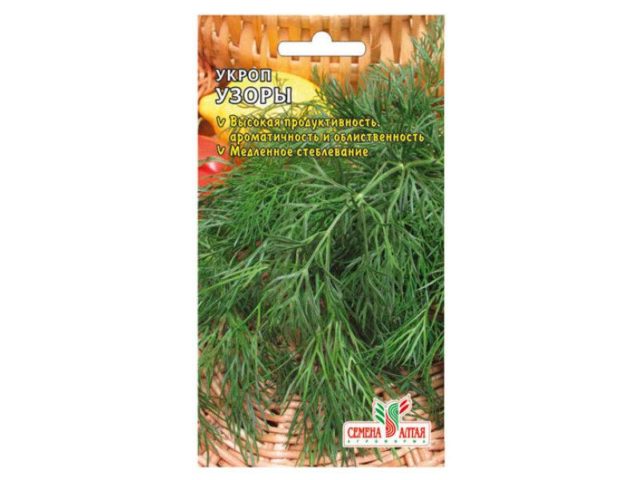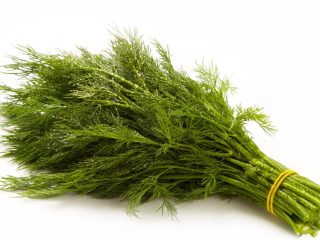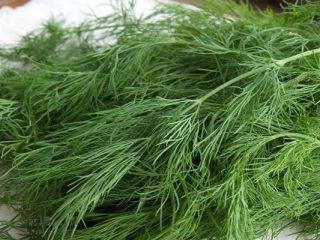Content
Tender juicy dill is used as a seasoning for dishes. With the appearance of inflorescences, the leaves of the plant become coarser and become unsuitable for food. Dill varieties for greens without umbrellas were bred by breeders to extend the life of this spicy plant.
Are there varieties of dill without umbrellas?
Dill is an annual plant of the Apiaceae family. The ripening double inflorescences contain seeds, which fall off in the fall and germinate the following year. Dill without umbrellas will not be able to reproduce.
In recent decades, many varieties with late stem formation have been developed. In these plants, umbrellas form much later. Therefore, the greens remain tender for a long time.
The best varieties of dill for greens
When choosing seeds for greens, it is better to give preference to bush varieties with late ripening. They are suitable for growing in open ground and greenhouses.These are dill varieties that can be cut several times if the conditions are favorable.
For open ground
To obtain fresh seasoning for salads, all varieties are suitable: from early to late. By choosing several types of different ripening periods, you can provide yourself with fresh dill from early spring to late autumn.
Lesnogorodsky
This is a mid-season variety with a friendly yield. The leaves do not turn yellow even after the formation of an umbrella. An adult plant reaches a height of 1.3 m. But leaves can be collected when the bush grows to 25 - 30 cm. From 1 sq. m you can collect up to 2 kg of spices. Dill is unpretentious to conditions and is suitable for repeated cutting.
In open ground, the Oblistvenny, Dalniy, Redut, and Umbrella varieties produce a good harvest.
For greenhouses and greenhouses
For cultivation in greenhouse conditions, tall varieties of medium and late ripening are recommended. Using them, you can grow dill, which grows again after cutting. This allows you to get the maximum yield of greenery even in the northern regions.
Boreas
Late ripening variety. The plant grows up to one and a half meters during the season with a sufficient amount of green mass. Leaves that do not turn yellow for a long time are a feature of this high-yielding Boreas.
Ducat
Tall, late-ripening variety, recommended for growing indoors. Slow stemming allows for high yields. Leaves can be collected 30 - 35 days after emergence. Due to the rapid development of the basal rosette, Dukat dill can be cut several times during the season.
Dill
The variety of Dutch selection is distinguished by particularly late stemming. When grown in greenhouses, it gives increased yield. The plant is tall.The harvest can be harvested within 28 - 30 days after germination.
Popular varieties of dill for greens by ripening time
When choosing seeds for planting, it is worth deciding on the purpose of growing the crop. If dill is used fresh for greens, then it is better to sow mid-late or late dill. This will allow you to get the largest possible harvest of fragrant leaves.
Early varieties of dill for greens
Early varieties are distinguished by the rapid formation of an umbrella. They are not suitable for growing greens. Already a month after germination, the leaves become coarser. Small plants have little foliage. To obtain maximum benefits, it is recommended to sow early ripening varieties of dill for greens in early spring or before winter.
Gourmet
This is an early ripening dill with late stem formation. Gourmand leaves are especially fragrant and tender. Its seeds are able to germinate at temperatures from 5 degrees Celsius. In open ground, Gourmet can tolerate light frosts. This variety is recommended for cultivation in regions with cold climates.
The greens of the plant are suitable for fresh consumption and retain their quality when frozen.
Grenadier
From germination to the first harvest it takes about 28 - 30 days. The plant reaches full ripeness in 70 - 75 days. High foliage allows you to harvest a fairly high yield of greenery before the leaves become coarse. The bushes of the variety are compact, low-growing (30 cm) and do not require special care. Productivity ranges from 1.5 kg per square meter.
Dill without umbrellas with medium ripening period
Plants with an average ripening period begin to form an umbrella 40 - 45 days after germination. The number of spicy leaves on each bush can reach up to 7 - 8 pieces.
Patterns
Mid-late variety with slow stem formation.In the ripeness phase, the bush reaches a height of about 140 cm. High foliage allows you to collect up to 50 g of leaves from one bush. It takes 40-42 days to harvest the greens. Full ripening occurs 3 months after germination. This variety is slightly susceptible to diseases.
Fluff
A new bush variety with late formation of umbels. The increased content of essential oils makes dill especially aromatic. Dark green rosettes of medium height keep the leaves soft for a long time. The collected greens are suitable for fresh use and for winter harvesting. The culture has increased resistance to powdery mildew and fungal diseases.
Kibray
A mid-season bush variety of dill without umbrellas, which got its name from the name of the city in Uzbekistan. The greens of the crop can be harvested within a month after germination.
Large rosettes of succulent leaves of rich bright green color up to 40 cm high provide a yield of up to 30 g of fragrant green mass per bush. Umbrellas form late. Full ripening of the plant occurs after 2.5 - 3 months from the emergence of seedlings. It is not very susceptible to powdery mildew.
Late-ripening varieties of dill without umbrellas
The highest yield can be obtained from plants with a late ripening period, which reaches 70 - 80 days. When grown in the regions of the middle zone, umbrellas of dill Kustysty, Amazon, Buyan appear by mid-August or September. In harsher climates, dill does not form an umbrella due to the short warm period.
Bushy
The most unpretentious variety of dill that does not grow in an umbrella for a long time. The spreading dark green rosettes of the plant can grow up to one and a half meters tall. The stem formation of the crop is later. The yield per bush is 30 - 40 g. The greens retain their color and softness for a long time, and are suitable for fresh consumption almost all summer.
The plant does not require special growing conditions. It is little susceptible to fungus and is suitable for cultivation in open ground.
Firework
The variety is famous for its high yield. Greens can be picked one and a half to two months after germination. A half-meter bush forms up to 30 large carved leaves. You can increase the yield by repeatedly cutting dill of this variety
Features of cultivation
Dill is an unpretentious crop. For many gardeners, this spicy plant appears in early spring as a self-sowing plant. Simple seeds do not require care, but the yield is small. You can provide yourself with aromatic green seasoning for salads and other dishes by sowing bush hybrids.
Hybrid varieties that have appeared in recent years require increased soil fertility and the creation of favorable conditions.
- When sowing bush varieties, it is necessary to fertilize the soil with compost or rotted manure.
- Hybrid bush plants take up a lot of space in the garden bed. When plantings are dense, the leaves quickly turn yellow and become unsuitable for harvesting.
- Most varieties are demanding on lighting.
- Caring for hybrids involves regular watering at least once a week. And in hot weather more often.
- Water stagnation should not be allowed on the site.
- To increase the yield, it is worth feeding the plants a week after germination with a complex fertilizer with a high nitrogen content.
- Removing developing flower stalks will help increase the yield of greens in open ground.
- Hybrid varieties are often susceptible to powdery mildew. You cannot use chemicals to combat fungus.
In the south and in regions with temperate climates, hybrid varieties produce a good yield of green mass in open ground. In areas with cold climates, film covers are needed in the spring to obtain high-quality greenery.
Conclusion
Dill varieties for greens without umbrellas should be selected based on the climatic conditions of the area. To obtain maximum benefits, you can use several types of crops of different ripening periods. You don't have to grow greens all year round. Frozen or dry leaves are well stored and retain all their beneficial qualities.





















